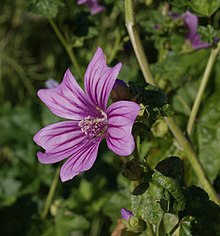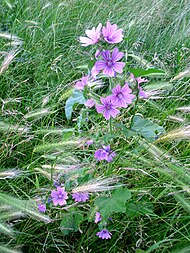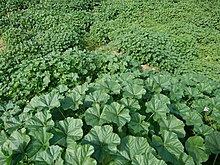Malva
| Malva | |
|---|---|

| |
| Malva sylvestris | |
| Scientific classification | |
| Kingdom: | Plantae |
| Clade: | Tracheophytes |
| Clade: | Angiosperms |
| Clade: | Eudicots |
| Clade: | Rosids |
| Order: | Malvales |
| Family: | Malvaceae |
| Subfamily: | Malvoideae |
| Tribe: | Malveae |
| Genus: | Malva L.[1] |
| Type species | |
| M. sylvestris[2] | |
| Species | |
| Synonyms[3] | |
| |


Malvais agenusofherbaceousannual,biennial,andperennial plantsin the familyMalvaceae.It is one of several closely related genera in the family to bear the common English namemallow.The genus is widespread throughout thetemperate,subtropicalandtropicalregions of Africa, Asia and Europe.[3]
The leaves are alternate, palmately lobed. The flowers are from 0.5–5 cm diameter, with five pink, lilac, purple or white petals.
Etymology
[edit]The word "mallow" is derived fromOld English"mealwe", which was imported fromLatin"malva",cognatewithAncient Greekμαλάχη (malakhē) meaning "mallow", both perhaps reflecting a Mediterranean term.[4]
In 1859, the colourmauvewas named after theFrenchname for this plant.
Uses
[edit]
Ornamental plant
[edit]Several species are widely grown as garden flowers.[citation needed]Very easily grown, short-lived perennials are often grown asornamental plants.[5]
Food
[edit]Many species are edible asleaf vegetables[5]and commonly foraged. Known asebegümeciinTurkish,it[which?]is used as vegetable in Turkey in various forms such as stuffing the leaves with bulgur or rice or using the boiled leaves as side dish.Malva verticillata(Chinese:Đông hàn thái;pinyin:dōngháncài,Korean:아욱auk) is grown on a limited commercial scale inChina;when made as a herbal infusion, it is used for its colon cleansing properties and as a weight loss supplement.[citation needed]
In theLevant,Malva nicaeensisleaves and fruit are used as food (e.g.,khubeza patties).
Mild tasting, young mallow leaves[which?]can be a substitute forlettuce,whereas older leaves are better cooked as a leafy green vegetable. The buds and flowers can be used in salads. Small fruits that grow on the plants can also be eaten raw.[5]
Bodos of Northeast India cultivate a subspecies ofMalvacalled lapha and use it extensively in their traditional cuisine, although its use is not much known among other people of India except in the northern Indian state of Kashmir whereMalvaleaves are a highly cherished vegetable dish called "Soachal".[citation needed]
Medical use
[edit]InCatalonia(Spain) they use the leaves to cure the sting orparesthesiaof the stinging nettle (Urtica dioica).
Leaves of various speciesMalvahave been used in traditional Austrian medicine internally as tea or externally as baths for treatment of disorders of the skin, gastrointestinal tract and respiratory tract.[6]The leaves can also be chewed to soothe coughs or sore throats.[5]
Cultivation
[edit]Cultivation is by sowing the seeds directly outdoors in early spring. The seed is easy to collect, and they will often spread themselves by seed.
SomeMalvaspecies areinvasive weeds,particularly in the Americas where they are not native.[3]
History
[edit]The third century BC physicianDiphilus of Siphnuswrote that "[mallow] juice lubricates the windpipe, nourishes, and is easily digested."[7]Horacementions it in reference to his own diet, which he describes as very simple: "Me pascunt olivae, / me cichorea levesque malvae" ( "As for me, olives, endives, and mallows provide sustenance" ).[8]Lord Monboddodescribes his translation of an ancientepigramthat demonstratesMalvawas planted upon the graves of the ancients, stemming from the belief that the dead could feed on such perfect plants.[9]
Species
[edit]The following 61 species are accepted:[3]
- Malva acerifolia(Cav.) Alef.
- Malva × adulterinaWallr.
- Malva aegyptiaL.
- Malva aethiopicaC.J.S.Davis
- Malva agrigentina(Tineo) Soldano, Banfi & Galasso
- Malva alceaL.– greater musk-mallow, vervain mallow
- Malva arborea(L.) Webb & Berthel.
- Malva × arbosiiSennen
- Malva assurgentiflora(Kellogg) M.F.Ray– island mallow, mission mallow, royal mallow, island tree mallow
- Malva bucharicaIljin
- Malva cachemiriana(Cambess.) Alef.
- Malva cavanillesianaRaizada
- Malva × clementii(Cheek) Stace
- Malva × columbretensis(Juan & M.B.Crespo) Juan & M.B.Crespo
- Malva creticaCav.
- Malva durieuiSpach
- Malva × egarensisCadevall
- Malva flava(Desf.) Alef.
- Malva hispanicaL.
- Malva × inodoraPonert
- Malva × intermediaBoreau
- Malva leonardiiI.Riedl
- Malva lindsayi(Moran) M.F.Ray
- Malva × litoralisDethard. ex Rchb.
- Malva longiflora(Boiss. & Reut.) Soldano, Banfi & Galasso
- Malva ludwigii(L.) Soldano, Banfi & Galasso
- Malva lusitanica(L.) Valdés
- Malva maroccana(Batt. & Trab.) Verloove & Lambinon
- Malva microphylla(Baker f.) Molero & J.M.Monts.
- Malva moschataL.– musk-mallow
- Malva multiflora(Cav.) Soldano, Banfi & Galasso
- Malva neglectaWallr.– dwarf mallow, buttonweed, cheeseplant, cheeseweed, common mallow, roundleaf mallow
- Malva nicaeensisAll.– French mallow, bull mallow
- Malva oblongifolia(Boiss.) Soldano, Banfi & Galasso
- Malva occidentalis(S.Watson) M.F.Ray
- Malva olbia(L.) Alef.
- Malva oxylobaBoiss.
- Malva pacificaM.F.Ray
- Malva pamiroalaicaIljin
- Malva parvifloraL.– least mallow, cheeseweed, cheeseweed mallow, small-whorl mallow
- Malva phoenicea(Vent.) Alef.
- Malva preissianaMiq.– Australian hollyhock
- Malva punctata(All.) Alef.
- Malva pusillaSm.– small mallow
- Malva qaiseriAbedin
- Malva setigeraK.F.Schimp. & Spenn.
- Malva stenopetala(Coss. & Durieu ex Batt.) Soldano, Banfi & Galasso
- Malva stipulaceaCav.
- Malva subovata(DC.) Molero & J.M.Monts.
- Malva sylvestrisL.– common mallow, high mallow
- Malva × tetuanensisPau
- Malva thuringiaca(L.) Vis.
- Malva tournefortianaL.
- Malva trimestris(L.) Salisb.
- Malva unguiculata(Desf.) Alef.
- Malva valdesii(Molero & J.M.Monts.) Soldano, Banfi & Galasso
- Malva verticillataL.– Chinese mallow, cluster mallow
- Malva vidalii(Pau) Molero & J.M.Monts.
- Malva waziristanensisBlatt.
- Malva weinmanniana(Besser ex Rchb.) Conran
- Malva xizangensisY.S.Ye, L.Fu & D.X.Duan
References
[edit]- ^"MalvaL. "Germplasm Resources Information Network.United States Department of Agriculture. 12 March 2007. Archived fromthe originalon 6 May 2009.Retrieved16 February2010.
- ^"MalvaL. "Index Nominum Genericorum.International Association for Plant Taxonomy.9 February 1996.Retrieved9 May2008.
- ^abcd"MalvaTourn. ex L. "Plants of the World Online.Board of Trustees of the Royal Botanic Gardens, Kew. 2017.Retrieved14 June2021.
- ^O.E.D (1989) 2nd.ed. vol.IX, p.271 col.3; P.Chantraine,Dictionnaire de la langue grecque,Klincksieck, Paris 1968, vol.2 p.662. The Italian linguist Vincenzo Cocco proposed an etymological link toGeorgianmalokhi,comparing alsoHebrewמַלּוּחַ (malúakh) meaning "salty". Gordon Douglas Young, Mark William Chavalas, Richard E. Averbeck, Kevin L. Danti, (eds.)Crossing boundaries and linking horizons: studies in honor of Michael C. Astour on his 80th birthday,CDL Press, 1997 pp.162-3.
- ^abcdNyerges, Christopher (2016).Foraging Wild Edible Plants of North America: More than 150 Delicious Recipes Using Nature's Edibles.Rowman & Littlefield. p. 100.ISBN978-1-4930-1499-6.
- ^Vogl, Sylvia; Picker, Paolo; Mihaly-Bison, Judit; Fakhrudin, Nanang; Atanasov, Atanas G.; Heiss, Elke H.; Wawrosch, Christoph; Reznicek, Gottfried; Dirsch, Verena M.; Saukel, Johannes; Kopp, Brigitte (2013)."Ethnopharmacological in vitro studies on Austria's folk medicine—An unexplored lore in vitro anti-inflammatory activities of 71 Austrian traditional herbal drugs".Journal of Ethnopharmacology.149(3): 750–71.doi:10.1016/j.jep.2013.06.007.PMC3791396.PMID23770053.
- ^Soyer, Alexis(1853).The Pantropheon: Or, History of Food and Its Preparation: from the Earliest Ages of the World.Ticknor, Reed, and Fields. p.64.
- ^Horace,Odes 31, ver 15,c. 30 BC
- ^Letter fromMonboddoto John Hope, 29 April 1779; reprinted by William Knight 1900ISBN1-85506-207-0.[page needed]
External links
[edit] Data related toMalvaat Wikispecies
Data related toMalvaat Wikispecies- .Encyclopædia Britannica.Vol. 17 (11th ed.). 1911. pp. 492–493.
